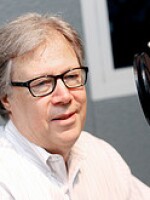It was an exhilarating journey, made all the more satisfying because it had to do exclusively with talent and artistry.
I know a lot of you around here recall watching with admiration and amazement the steady rise of the, as they moved from complete unknowns to a place at the very pinnacle of the string quartet world.
That’s because you had a ringside seat: the Emersons showed up in our community in 1980, having been appointed to a one-year residency at The Hartt School, the performing arts conservatory of the University of Hartford. That one-year appointment stretched into a remarkable -- and I think we can safely say, never to be repeated -- 21-year ride.
More about that ride in a moment.
One of the hallmarks of the Emerson career -- at least, the first four decades of it -- was the steady string of recordings the quartet put out for Deutsche Grammophon. (Again, mostly because of the way the music business works these days, such a long single-label marriage is itself a phenomenon that will never be repeated.)
Thankfully, DG has just issued a plump boxed set containing all the recordings the foursome did for the label. The box runs to 52 discs.
It’s available from , of course, or if you prefer to patronize a company that heroically offers classical recordings and nothing but classical recordings, from .
The set is a nice souvenir of the Emersons' ambitious, wide-ranging musical appetite: the complete cycles of Beethoven, Shostakovich, Bartok, and Mendelssohn, plus assorted standard-rep specimens by Dvorak and Tchaikovsky, along with less-standard staff by Schuller, Ives, Harbison, Edgar Meyer and other moderns.

I should note year that the quartet's membership went unchanged for a remarkable 34 years, from 1979 to 2013, and these recordings were made during that period. In 2013, cellist David Finckel stepped away from the group and was replaced by Paul Watkins.
There is, as they say, some bonus material, including a disc of encores and a new introductory essay by Emerson violinist Eugene Drucker.
Back to the Emersons’ dramatic journey, as we experienced it here in Hartford:
When the group arrived at Hartt (it was the school’s first stab at engaging an outside resident string quartet) there was, in all candor, a fair amount of skepticism. The quartet members were in their 20s, barely out of graduate school. They were, to put it charitably, unheralded.
Their first concerts at the school’s 400-seat Millard Auditorium were sparsely attended. There was some grumbling that maybe the residency idea hadn’t been all that well thought out.
But the school, and the quartet, hung in there. And little by little things began to change. The group landed its recording deal with DG, and also began winning awards and prizes.
First a Grammy Award, and then a Gramophone Magazine award (that’s the high-toned British classical music monthly), then some glowing national reviews. Then more Grammys (nine now and counting), then a residency at the Smithsonian, a Musical America “Ensemble of the Year” designation, etc., etc.
After a quiet and even unpromising beginning, their residency picked up steam. Their subscription concerts began to sell out. By and by, the concerts had to be moved to the university’s 725-seat Lincoln Theatre, and in short order they started to fill that up.

Before our eyes, and without any special fanfare or strenuous publicity machine, the Emersons had gone from obscure newbies to rising stars to established eminences to -- in the view of many listeners and critics -- the preeminent quartet on the globe.
It really was an exhilarating journey, made all the more satisfying to behold because it had to do exclusively with talent and artistry.
If you are so inclined, you are welcome to read a slightly expanded, semi-personal account of that journey that I wrote for in 2002, when the Emersons -- by now middle-age men with families and mortgages -- decided to conclude, amicably, their Hartt residency.
Heavenly Jam Session Adds Two Members
The music world lost two notable figures last week:
, a classically trained American soprano who was admired in the profession for her interpretations of serious modern music, but who will be better remembered as the dubbed-in singing voice of various vocally challenged film actresses, died July 24 at her Manhattan home.
I guess by now most people who pay attention to the music profession at all knew that Nixon sang for Deborah Kerr in The King and I, for Natalie Wood in West Side Story and, somewhat more controversially, for Audrey Hepburn in My Fair Lady. I say controversially because Hepburn had an attractive voice in her own right, and wanted desperately to do her own singing on the soundtrack.
But what you might not have known (I didn’t) was that she spliced in a single troublesome phrase for Marilyn Monroe in the song “Diamonds are a Girl’s Best Friend” from the film Gentlemen Prefer Blondes. Thanks to the great Margalit Fox of the New York Times for that piece of musico-biographical information.
In a slightly different category, last week the world also lost singer/producer/songwriter.
Paxton, who lived 77 eventful years, began his music career at age 17 when he wrote and, with a high school friend, recorded a ballad called “It Was I.” The duo called themselves Skip and Flip, and their song made it to number 11 on the national pop charts.
Among many other far-flung credits, Paxton was also the producer on two classic novelty songs, “Alley Oop,” on which he also sang, and “Monster Mash,” on which he didn’t, although it could be argued that the song’s credited interpreter, one Bobby “Boris” Pickett, didn’t either.
Paxton claimed to have composed more than 2,000 songs altogether. Among the last of these was the perhaps sadly prescient, “When I Die, Just Bury Me at Wal-Mart (So My Wife Will Come Visit Me).”


